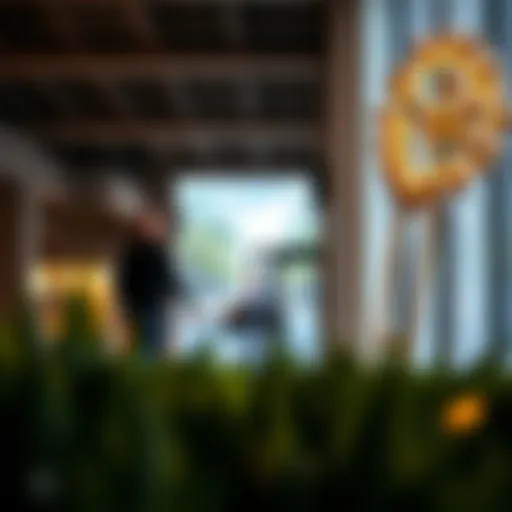The Role of Palace Towers in Dubai's Real Estate Market
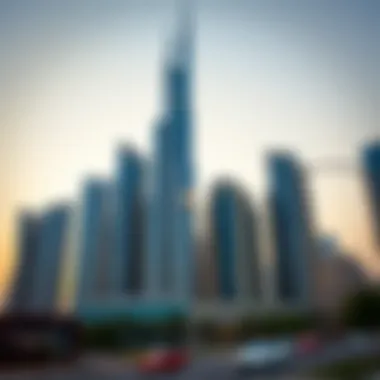
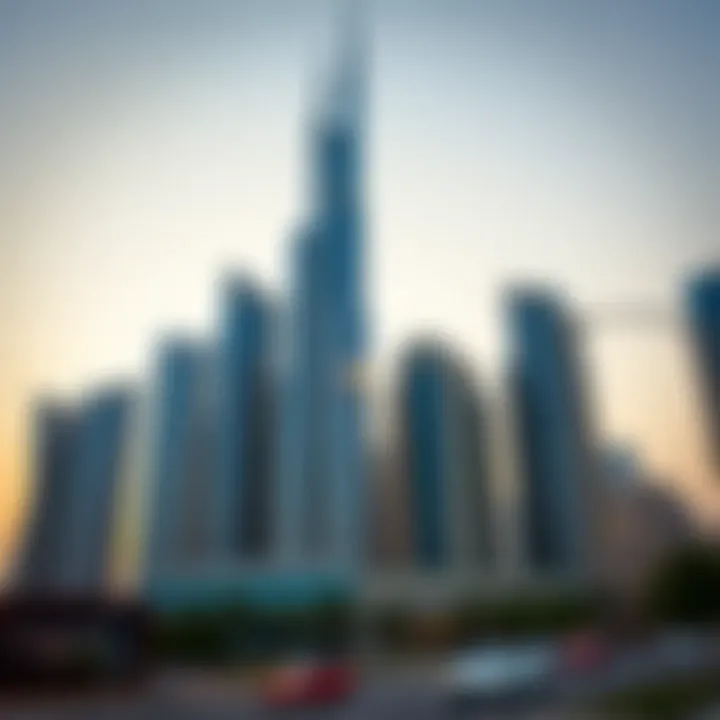
Intro
Whether you're contemplating purchasing property, investing, or simply understanding the urban aesthetic that palace towers contribute to, it’s essential to grasp their multifaceted role. These towering works of art not only accentuate the skyline; they influence property values and embody the lifestyle that many associate with Dubai. From local residents to international investors, the fascination with palace towers spans cultures and geographies. The towers represent potential, both in investment opportunities and in the lifestyle they promise.
In the following sections, we will delve into the current trends within Dubai's real estate market impacted by these architectural marvels, as well as offer strategies for potential investors looking to make a mark in this vibrant landscape.
Intro to Palace Towers
Palace Towers represent a unique fusion of culture, architecture, and economic potential within Dubai's vibrant real estate market. The significance of these towers goes beyond their impressive aesthetics, cementing their role as pivotal landmarks that embody both luxury and modernity. They illustrate how the ambitions and visions of the Emirati people translate into tangible structures that direct the urban narrative of this bustling metropolis.
Defining Palace Towers
At their core, palace towers consists of towering structures designed to reflect the grandeur and opulence traditionally associated with royal residences in the region. Characterized by intricate architectural elements, these buildings often showcase a blend of Islamic and contemporary design styles, indicating a dialogue between history and modernity. For an investor or homebuyer, understanding what defines these towers is crucial, as it shapes their appeal in the marketplace.
The term "palace towers" can refer to both residential and mixed-use developments. While often situated within prime real estate areas, they’re not merely functional spaces; they embody an experience. Features such as panoramic views, high-end amenities, and superior construction techniques point to their significance. A prospective buyer who seeks to rent or invest in these properties must appreciate their unique standing in the culture and economy.
Historical Significance
The historical trajectory of palace towers in Dubai tells a story of transformation. Originally inspired by the rich architectural heritage of the Arab world, these structures began to emerge alongside the rapid urbanization of the late 20th century. Their evolution illustrates Dubai’s transition from a modest trading port to a global hub of commerce and tourism.
"Each palace tower tells a tale, not just of architectural ambition, but of societal evolution and economic diversification."
From the early days when the Emirates sought to establish its identity, the construction of palace towers signaled an ambition to compete on the global stage. These buildings have often been at the forefront of new architectural trends that cater to a luxury market, thus reflecting shifts in lifestyle preferences among both residents and expatriates.
Furthermore, palace towers have served not only as residences but as symbols of aspiration. They attract international investors, which reinforces the notion that real estate in Dubai is a sound investment. In this regard, understanding the historical layers adds depth to their significance, enabling potential investors to make informed choices based on historical context and current trends.
In summary, palace towers are vital to comprehending the evolution and economic landscape of Dubai's real estate. Their dual role as luxury living spaces and cultural symbols makes them an intriguing subject for real estate enthusiasts and investors keen to engage with the emirate's future.
Architectural Features of Palace Towers
When talking about the architectural features of Palace Towers, one must grasp not just their visual splendor but also their role in enhancing the overall ambiance of Dubai's skyline. These towers are not just structures but landmarks embodying the city’s rapid urbanization and affluence. The elegance and sophistication of their design cater to both an aesthetic appreciation and functional superiority that appeals to investors, homebuyers, and property managers alike.
Design Elements
Palace Towers exemplify a blend of traditional Emirati artistry and contemporary design, creating an architectural dialogue between the past and present.
- Aesthetic Influence: The towers often showcase intricate Islamic geometric patterns and calligraphy that pay homage to the region’s rich heritage. This unique fusion of designs serves as a reminder of cultural roots while appealing to modern tastes.
- Height and Scale: Many Palace Towers reach impressive heights, making them landmarks that are easily identifiable across the urban sprawl. Their towering presence not only enhances the city's skyline but also instills a sense of pride among local residents.
- Materials and Texture: Quality materials such as glass, steel, and stone are commonly used in construction. This ensures durability and offers a luxurious appearance. The reflective surfaces of glass allow the towers to shimmer in sunlight, creating a captivating sight.
- Landscaping: The grounds surrounding these towers are often meticulously landscaped, featuring gardens, water features, and pathways that are aesthetically pleasing and offer a mini-escape from the urban hustle.
The combination of these elements results in buildings that serve as both residential homes and symbols of prestige. Investors recognize this as a crucial selling point, enhancing property values and attracting discerning buyers.
Technological Innovations
Incorporating the latest technological advancements, Palace Towers set a precedent in how residential and commercial spaces are designed and utilized:
- Energy Efficiency: Modern Palace Towers often employ sustainable practices such as solar panels and energy-efficient HVAC systems, significantly reducing their carbon footprint.
- Smart Home Features: Many units within these towers come equipped with smart technologies, enabling homeowners to control lighting, security, and climate through their devices. This level of automation caters to the tech-savvy consumer looking for convenience.
- Enhanced Safety and Security: State-of-the-art security systems, including biometric access control and 24/7 surveillance, ensure the safety of residents, making these towers a secure investment.
"The architectural landscape of Dubai is a testament to innovation and opulence, with Palace Towers standing as pillars of modern living." - Dubai Land Department
- Sustainable Water Management: Advanced water recycling systems are now common in new developments, ensuring an eco-friendly approach to living and promoting conservation efforts.
- Construction Techniques: Innovations in construction methods, such as modular construction and the use of cranes, shorten project timelines and enhance build quality.
Cultural Relevance in Dubai
Cultural relevance in Dubai is pivotal when examining the landscape of palace towers, as these structures transcend mere real estate to embody deeper social narratives and Emirati identity. The palace towers often reflect the region's rich heritage, showcasing a blend of traditional motifs and modern design. In the tapestry of Dubai's rapid development, these buildings stand as icons, reminding residents and visitors alike of the history and values that shape Emirati culture.
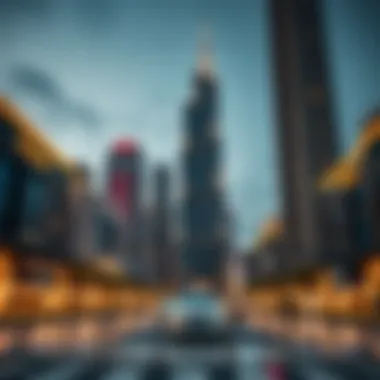

Symbolism in Emirati Culture
The palace towers symbolize the aspirations and progress of the Emirati people. They are not just residential or commercial spaces; they represent the dream of a nation that aims to foster luxury and innovation while remaining deeply rooted in tradition. This duality is significant. For many local citizens, the towers embody a sense of pride. These structures are often viewed as modern marvels, incorporating elements of Islamic architecture with cutting-edge design. A tower reaching skyward might evoke memories of ancient minarets and forts, bridging past and present, and embodying the resilience of a society that has evolved over decades.
Additionally, these towers often act as gathering points, fostering community and a spirit of belonging. People come together in shared spaces, whether for cultural events or simply to experience the ambiance that permeates the vicinity of these grand structures. Thus, the cultural symbolism of palace towers is instrumental in not only shaping the skyline but also the community spirit of Dubai.
Public Perceptions of Luxury
In the eyes of both locals and expatriates, palace towers reflect a heightened standard of living. The very mention of luxury in Dubai conjures images of opulent residences and sprawling amenities. The public perception of these towers can sometimes skew towards exclusivity. Many see them as status symbols—adorned with luxurious interiors, high-end retail outlets, and breathtaking views that claim the horizon. This perception feeds into the larger narrative of what it means to live in Dubai, where excess often equates to success.
However, there is also a growing discourse around accessibility and community within these towers. While they are undeniably luxurious, many residents advocate for inclusivity, balancing opulence with a welcoming atmosphere. This push reflects a desire for sustainability in luxury living. The challenge lies in maintaining that balance—ensuring that not just a select few, but a wider spectrum of society can partake in the lifestyle that these towers promise.
With the global spotlight on Dubai, the public perception of luxury will continue to evolve. Investors and homebuyers seeking to understand this dynamic environment must recognize that wealth isn't solely measured by square footage or views but also by the richness of experiences and community living.
"In Dubai, luxury is not just about how high you can build but how well you can integrate with the community around you."
As the narrative unfolds, palace towers will remain essential to this discussion—both as cherished landmarks and as pivotal players in the evolving tapestry of Dubai's real estate landscape.
Current Trends in Palace Tower Developments
The current trends in palace tower developments in Dubai represent more than just a shift in architectural styles; they mirror the evolving desires of residents and investors alike. As the city catapults into the future, staying informed about emerging trends is paramount for investors, homebuyers, and property managers. This intricate web of contemporary designs, lifestyle aspirations, and technological innovations proffers extensive insights into the real estate market.
Emerging Projects
Dubai continues to unveil an array of palace tower projects that challenge the status quo and push the boundaries of luxury living. For instance, the recent debut of the Al Warsan Palace Tower has garnered attention due to its blend of traditional Emirati aesthetics fused with modern amenities. This development highlights a significant inclination toward spaces that embody cultural heritage while integrating cutting-edge design.
Moreover, projects like the Dubai Creek Tower are reshaping the skyline, promising not only sky-high living but also panoramic views. Investors are particularly keen on these types of developments as they offer a potential for high returns, driving both interest and demand.
Beyond mere aesthetics, these emerging projects focus on enriching community spaces. Developments now aim to include parks, retail spaces, and cultural hubs that encourage interaction among residents, fostering a sense of belonging. This aspect is especially critical as urban residents seek lifestyle experiences that extend beyond their apartment walls.
Sustainability Practices
Sustainability is at the forefront of new palace tower developments and is a crucial consideration for investors who are increasingly aware of the environmental implications of their choices. The integration of green technologies is not merely a trend but a necessity. Many projects actively incorporate solar panels and energy-efficient materials to minimize their carbon footprint.
For example, the Palace Green Tower showcases a commitment to eco-friendly practices, featuring rainwater harvesting systems and low-energy lighting. These measures not only reduce operational costs but also appeal to environmentally-conscious buyers, aligning investments with personal values.
Additionally, developers are paying closer attention to the landscaping around palace towers, emphasizing the importance of green spaces in urban environments. These areas often include community gardens and recreational zones that enhance the quality of life for residents.
"Sustainable developments reflect a broader vision: neighborhoods that are not only luxurious but also considerate of future generations."
Understanding the trends in sustainability makes for a more informed investment, as properties that embody eco-conscious principles are more likely to retain their value in an increasingly eco-aware market.
In summary, being attuned to the current trends in palace tower developments reveals crucial insights into the broader real estate landscape of Dubai. From innovative architectural responses to the cravings for luxury and community, to sustainability practices driving the future, these trends encapsulate the dynamic nature of urban living. Investors who recognize these shifts are better equipped to navigate this vibrant market.
Investment Potential of Palace Towers
Investment in real estate has always been a hot topic for many, but few areas captivate the imagination like the Palace Towers of Dubai. These structures aren’t just architectural marvels; they represent a unique opportunity for investors, homebuyers, and property managers alike. As urban landscapes in Dubai continue to evolve, understanding the potential wrapped around these ethereal towers is vital.
Market Analysis
A pivotal aspect of discerning the investment potential of Palace Towers involves a thorough market analysis. Looking at factors such as demand, property appreciation rates, and the economic backdrop is essential. Over the last decade, Palace Towers have become synonymous with luxury, and with that, the prices have gone up.
- Demand Dynamics: The demand for high-end properties in Dubai has shown resilience even in fluctuating market conditions. Factors like a growing expatriate population and improved infrastructure often spur interest in areas surrounding Palace Towers.
- Price Trends: Historically, investments in real estate in regions near Palace Towers have yielded returns that outpace average market growth. Due to amenities and the exclusive lifestyle they offer, properties in these areas tend to appreciate consistently.
- Economic Indicators: In recent years, Dubai’s tourism and business sectors have expanded, creating a stable economic environment. This growth translates into more potential buyers and tenants seeking residences close to cultural and commercial hubs, like the Palace Towers.
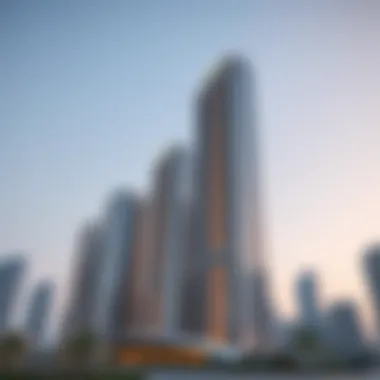
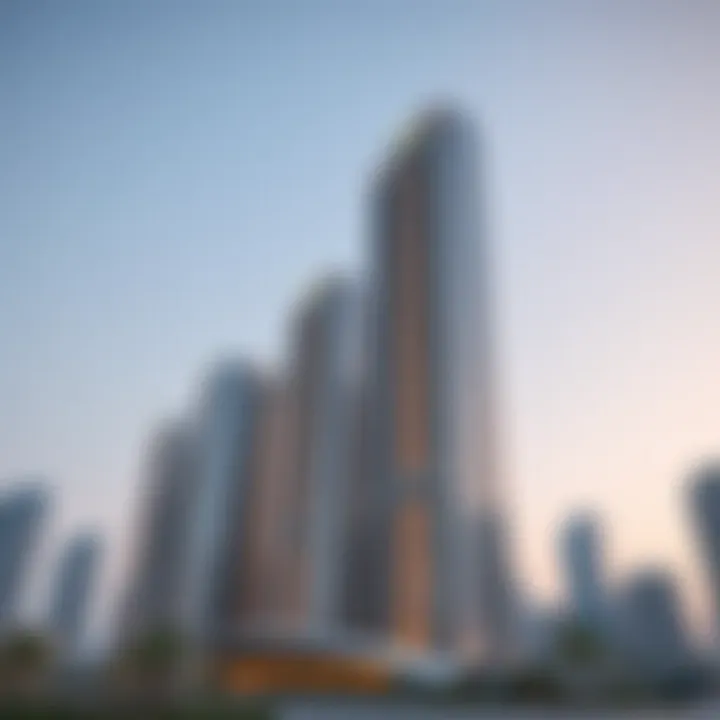
"Investing near Palace Towers is not merely a transaction; it’s a long-term strategy that taps into Dubai's thriving economy."
Renting vs. Buying
When it comes to deciding between renting and buying in the vicinity of Palace Towers, potential investors need to weigh their options carefully. Each choice carries its own set of advantages and challenges.
- Renting:
- Buying:
- Flexibility: Renting often appeals to those who value mobility or wish to avoid the long-term financial commitment of buying. With high demand for rental properties adjacent to Palace Towers, investors can capitalize on steady income without the hassle of property management.
- Lower Initial Cost: The initial costs related to renting are typically far lower than buying. This lowers the barrier for entry for many potential investors.
- Asset Ownership: Purchasing property brings tangible asset value. Over time, real estate usually appreciates, making it a sound investment decision for those considering long-term financial stability.
- Control Over Property: Ownership provides more freedom to make improvements or modifications. Investors can create spaces that attract premium tenants, thus enhancing rental yields.
In summary, both renting and buying present attractive opportunities near Palace Towers, depending on the investor’s financial strategy and personal goals. It's crucial for potential buyers to assess their financial health and market conditions before making decisions.
Living Experiences Near Palace Towers
Living in proximity to palace towers can significantly shape one’s day-to-day experience. This topic is crucial as it intertwines lifestyle, usability, and social dynamics in a neighborhood that prides itself on luxury and opulence. Exploring the living experiences near these architectural wonders provides insights into not just the property values but also the cultural milieu that surrounds them, which can be a decisive aspect for both investors and homebuyers alike.
Lifestyle Aspects
When you consider residing near palace towers, the emphasis on luxury is hard to ignore. The lifestyle that comes with such an address is undoubtedly attractive. Many residents experience a blend of modern living encapsulated in the essence of Emirati culture. For example, walking through streets lined with intricate designs, exquisite fountains, and vast greenery becomes part of one's daily commute. Public spaces are meticulously maintained, providing local parks and relaxation areas that contribute to a tranquil yet vibrant ambiance.
Additionally, the social fabric of the area reflects a mix of global cultures. Residents often enjoy a diverse selection of dining options, ranging from high-end international restaurants to traditional Emirati cuisine, giving one ample choices to satisfy any palate. This accessibility to global cuisine enhances the community's lifestyle, making it a melting pot of experiences.
A further factor to consider is the recreational offerings. Numerous leisure facilities are often within arm's reach. Gyms, pools, and wellness centers contribute to an active lifestyle, tying in well with the luxurious environment of the palace towers. Living here can mean not just a place to stay, but a lifestyle that encourages health, community, and indulgence.
Amenities and Services
Amenities near palace towers often go beyond basic conveniences; they embody an ethos of luxury and ease that complements the lavish living experience. One of the most indispensable features here is the proximity to shopping malls like Dubai Mall and Mall of the Emirates. These malls are not just shopping destinations; they serve as communal hubs for entertainment and leisure.
"The amenities near palace towers function as a microcosm of the luxurious lifestyle that Dubai boasts."
Residents have access to an array of services like concierge, housekeeping, and even personal shopping. Such offerings elevate the standard of living, catering to the whims and needs of those who can afford them.
Moreover, the presence of schools and healthcare facilities adds peace of mind for families residing in the area. Esteemed educational establishments providing international curriculums sit within a short drive, while top-notch health clinics offer reliable medical care, reinforcing the notion that living near palace towers is often practical as well.
In summary, the living experiences near palace towers in Dubai represent more than just a real estate investment. They create a lifestyle enriched with cultural nuances, world-class amenities, and a unique social ethos, attracting investors and homebuyers eager to be part of this dynamic urban fabric.
Influence on Surrounding Communities
The Palace Towers in Dubai are more than just striking architectural achievements; they serve as vital components in the urban tapestry of the city, impacting local communities on multiple levels. Their presence influences urban development and shapes social dynamics, making them pivotal to understanding Dubai's real estate landscape. As local investors and homebuyers gear up to navigate this intricate market, recognizing the influence of Palace Towers on surrounding neighborhoods becomes increasingly significant.
Urban Development Impact
Palace Towers act as beacons for urban development. When these towering structures are erected, they often herald a wave of infrastructural and economic growth. The immediate vicinity tends to experience enhancements in both urban planning and community facilities. Roads are improved, parks are developed, and public transport options expand, ultimately benefitting the residents. In addition:
- Increased Property Values: Properties near Palace Towers often see a surge in value, reflecting their desirability. As such, they attract buyers looking for prime locations.
- Business Opportunities: The commercial landscape around Palace Towers flourishes, with a rise in retail outlets, cafes, and service providers catering to a growing population. This progress creates job opportunities, fostering economic development.
- Enhanced Public Services: As more residents move into the area, demand for vital services such as schools, hospitals, and emergency services increases, pushing local governments to invest in these facilities, which in turn improves quality of life.
This ripple effect underscores how Palace Towers can catalyze significant urban growth.
Social Dynamics
The community surrounding Palace Towers evolves along with the structural developments, leading to shifts in sociocultural interactions. The presence of such luxurious towers attracts a diverse demographic, which influences the social fabric of the area. Key aspects include:
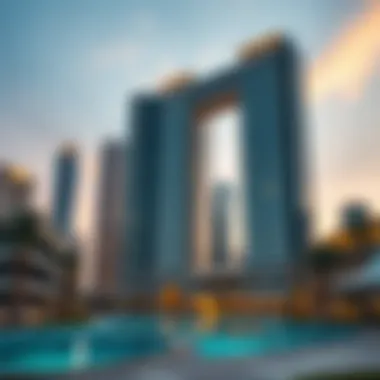
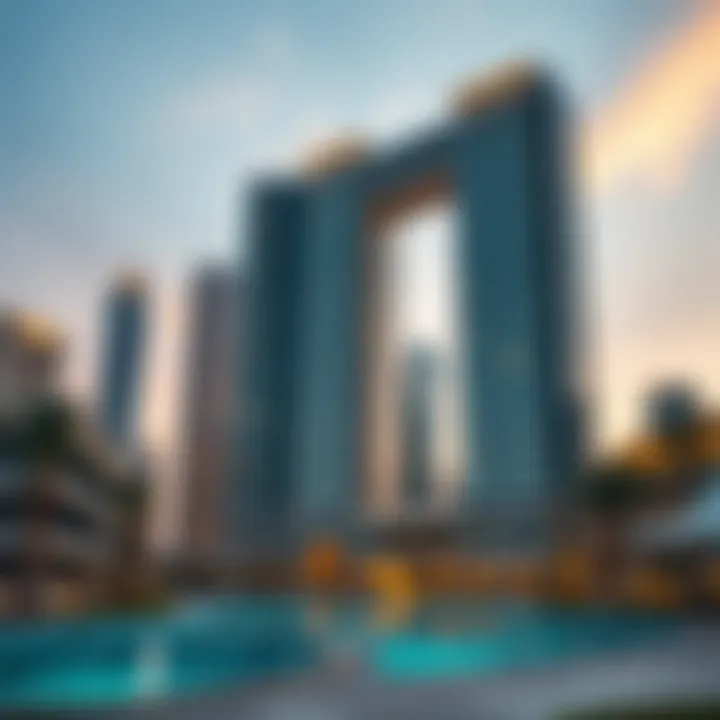
- Cultural Exchange: With a mix of luxury accommodations and residential options, Palace Towers encourage the interaction of varied cultures. This melting pot fosters a rich exchange of ideas, traditions, and lifestyles, thereby enhancing community bonds.
- Local Events and Activities: Often, the upscale nature of Palace Towers leads to an uptick in high-profile events and gatherings. These activities promote community engagement, whether through art exhibits, festivals, or charity events, actively uniting residents from different walks of life.
- Network Building: The networking opportunities generated by living or working near these towers cannot be understated. For investors and professionals, being in proximity to Palace Towers provides opportunities to connect with like-minded individuals, creating new ventures and collaborations that can lead to further economic activity.
The social dynamics shift towards a more cosmopolitan ethos, fostering both community and personal growth. As investors observe these changes, understanding the community's fabric enhances their property decisions, potentially leading to more sustainable investments in the long run.
Comparative Analysis with Other Global Cities
In today’s interconnected world, comparing Palace Towers in Dubai to similar structures in global cities offers valuable insights into their standing in the international real estate market. This analysis highlights crucial aspects such as accessibility and real estate values, enriching our understanding of the Palace Towers' role in Dubai's urban identity.
Palace Towers Accessibility
Accessibility plays a significant role in determining the attractiveness of residential and commercial skyscrapers, including Dubai's Palace Towers. Comparing accessibility features of Palace Towers with their counterparts in cities like New York and London provides a broader context.
- Transportation Networks: Palm Towers, for instance, benefit from Dubai's comprehensive public transport system, including the Metro and bus services. This contrasts with London's Canary Wharf, where the Docklands Light Railway and Jubilee Line serve its towers. The ease of access can dramatically influence not only the appeal of these structures but also their market value.
- Proximity to Key Areas: Palace Towers are strategically placed near essential amenities. The close-knit nature of Dubai, supported by its urban planning, ensures minimal travel time to business districts, like DIFC, and leisure spots, unlike towers in sprawling cities such as Los Angeles, where distances can be daunting.
- Pedestrian Facilities: In Dubai, the infrastructure supports a pedestrian-friendly environment around the Palace Towers, making it more appealing for families and young professionals. In contrast, many towers in New York may lack adequate pedestrian pathways in their surrounding areas, affecting overall livability.
This accessibility not only influences daily commuting but also shapes the overall urban experience for residents and visitors alike, ultimately affecting property demand and rental prices.
Real Estate Value Comparisons
Understanding how the value of Palace Towers stacks up against global counterparts is vital for investors and property managers. When drawing comparisons, several parameters come into play:
- Avg. Cost per Square Foot: In Dubai, a luxury apartment within a Palace Tower can command prices that are competitive with those in prestigious areas of cities like Paris and Hong Kong. For instance, the average price per square foot in a Palace Tower might hover around AED 1500, close to luxurious properties in other major cities, which can reach similar or higher figures.
- Long-term Growth Potential: Analyzing the historical appreciation rates can offer insights into investment viability. Whereas properties in some oversaturated cities might plateau, Dubai's strategic growth policies, including tourism and business sector investments, suggest a more optimistic outlook for Palace Towers.
- Occupancy Rates: High occupancy rates in Palace Towers compared to other global cities bolster their attractiveness. Typically, these towers maintain an average occupancy rate above 90%. When you look at similar luxury buildings in San Francisco or Sydney, some might struggle to keep up due to market saturation or economic shifts.
"Investment in Palace Towers not only reflects a choice of lifestyle but also a smart economic move in a city with constant growth potential."
To sum up, this comparative analysis not only sheds light on the unique characteristics of Palace Towers but also underscores their prominent place in the global real estate arena. Investors, homebuyers, and property managers benefit significantly from understanding these dynamics, which can guide informed decisions.
Future of Palace Towers in Dubai
The future of palace towers in Dubai represents not just an architectural vision but also a significant thread woven into the broader tapestry of real estate development in this metropolis. As Dubai continues to evolve as a global hub for business, tourism, and luxury living, the trajectory of these iconic structures is critical for investors, homebuyers, and property managers alike. Their influence on urban patterns, property value, and cultural identity should not be underestimated.
Projected Developments
Looking ahead, the anticipated developments around palace towers are poised to set new benchmarks in Dubai's real estate landscape. Recent announcements hint at several new palace tower projects that promise not only to redefine skylines but also enhance the overall living experience. For example, projects that incorporate mixed-use spaces combine residential, retail, and cultural offerings stack the odds in favor of diversifying property value and attracting varied demographics. In this regard, key focus areas include:
- Sustainability: Developers are increasingly prioritizing environmentally responsible building practices. Projects like the Dubai Sustainability City set the stage for palace towers with energy-efficient systems and extensive green spaces, providing a blueprint for future endeavors.
- Technological Integration: Smart home technologies and automated systems are gaining traction. Expect future palace towers to feature cutting-edge amenities, enhancing comfort and security for residents.
- Cultural Centers: New developments might include cultural hubs that echo Emirati heritage, establishing a sense of place that resonates with the community. These elements can serve as a magnet for domestic and foreign investments, bridging past and future.
Shifts in Architectural Trends
The architectural landscape surrounding palace towers is likely to experience transformations that reflect both global influences and local preferences. As such, several significant shifts can be observed:
- Minimalist Designs: Simplicity in design is becoming increasingly favored among discerning investors. The shift towards minimalism marks a movement away from ostentatious styles that characterized earlier phases of development. Clear lines, functional spaces, and an emphasis on natural light are key components that define this trend.
- Cultural Fusion: Architects are beginning to blend traditional Emirati elements with modern aesthetics. This fusion tells a story, weaving cultural narratives into the very fabric of the buildings, making them not just residences, but landmarks of identity.
- Vertical Landscapes: Expect taller structures that utilize vertical gardens and landscaped terraces. Integrating green spaces upward can enhance the living experience while promoting biodiversity in urban settings.
"The next era for palace towers in Dubai might just redefine not only how we see luxury but also how we experience community and sustainability."
Investors and homebuyers should keep these trends in mind, as they will not only shape the architectural ethos but also influence market dynamics and property desirability in the coming years. In essence, future palace towers will likely be emblematic of a new age, where urban development intertwines seamlessly with cultural significance and contemporary needs.
Epilogue: The Lasting Legacy of Palace Towers
The Palace Towers have forged a distinctive identity within Dubai's intricate real estate landscape. Their presence is not just a feature of the skyline, but a silent testament to the evolving narrative of the city’s ambition and cultural aspirations. These towers symbolize a blend of luxury living and modern architectural prowess, crafting a unique environment for those drawn to the allure of high-end residences.
As we dissect the legacy of these remarkable structures, it becomes evident that their importance extends beyond merely providing luxurious living spaces. They are pivotal in shaping urban aesthetics and play a crucial role in enhancing property values in their vicinity. Investors seeking opportunities within this realm must consider factors such as location, market desirability, and future developments that could further elevate the status of Palace Towers within the market.
Several specific elements contribute to the lasting impact of Palace Towers:
- Cultural Integration: The architectural designs reflect a deep understanding of local traditions while embracing modernity. This fusion attracts both local and international buyers.
- Economic Development: As landmarks, Palace Towers stimulate economic growth in their neighborhoods, leading to increased demand for commercial and residential properties alike.
- Lifestyle Appeal: The amenities connected to these towers cater to a lifestyle that many aspire to, making them ever more attractive to potential residents.
"The Palace Towers are more than just residential buildings; they are icons of luxury that define Dubai's skyline and socio-economic landscape."
For more in-depth exploration of Dubai's real estate nuances, resources like Dubai Land Department provide extensive information while insights can be drawn from real estate forums such as Reddit's r/Dubai for community perspectives.









